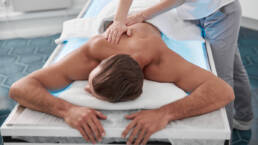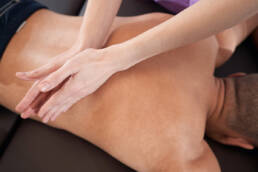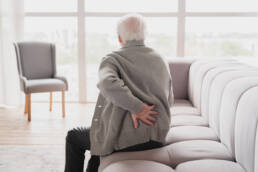You’ve heard about how great chiropractic care can be, and you may have even tried it for yourself. However, not all chiropractors work the same way or offer the same benefits. Discover five ways structural chiropractic correction works, and why you should include it in both your injury treatment plan and your normal health regimen.
What Is Chiropractic Structural Correction?
Before getting into how this particular form of chiropractic care helps, it’s important to understand what it is. Let’s start with what most people think of when it comes to chiropractic care. The initial form of treatment is known as the traditional method of treatment, which works to reduce the patient’s pain and increase their mobility. These are called secondary conditions that are caused by a structural shift.
It’s important to treat these aspects being this is what brings most people into a chiropractic clinic in the first place. However, if that’s where the treatment stops, then they will likely end up with recurrent pain in the near future. Structural chiropractic goes deeper by focusing on the spine’s foundation.
This looks at what caused the misalignment or nerve compression in the first place. Once the chiropractor identifies this, they’ll address vertebra shift changing muscles, tendons, nerves, and ligaments through stimulation and aligning bones and joints.
Rather than relying solely on how your back feels, structural chiropractors use multiple examination techniques, including thermal scan, surface electromyography, and structural radiographs, also known as x-rays. A structural chiropractor then uses these evaluations to develop an appropriate treatment plan.
Reduces Nerve and Nerve Bundle Associated Pain
As previously mentioned, pain is actually a secondary symptom caused by a structural shift. These structural shifts affect your nerves, triggering your pain receptors.
One of the many conditions that structural chiropractors see is the herniated disc. This is when a disc becomes misplaced due to a shift in the vertebra in the spine. That displaced disc presses against the bundle of nerves known as the sciatic nerve. This often leads to referred pain, numbness, and muscle weakness down the leg.
Other joints can become problematic as well, causing what many refer to as a pinch in the joint. The solution to resolving this pain is working with the joint and supporting structures to move back into their proper place and stay there. In addition to correcting the underlying structural shift, structural adjustments also release pain-relieving endorphins.
Improved Nutrient Flow
In order to work properly, every cell of your body needs nutrients. When some cells are starved for nutrients you may experience pain being they don’t have what’s needed to complete their cellular function. Many of the cells in your body derive their nutrients from blood flowing to the areas.
However, joints don’t actually have a blood supply. Rather, they receive their nutrients through what’s known as synovial fluid. This fluid lubricates joints when they are in motion, but when you’re sedentary that fluid doesn’t flow.
Structural chiropractic adjustments help get that synovial fluid moving. Over continued treatment, your joint flexibility can improve, reducing your pain and improving your joint flexibility.
Improved Strength
Structural shifts often go ignored for some time, leaving you in some amount of pain for extended periods of time. You start learning to guard your movements, or become less active in order to protect yourself against that pain. However, restricted movement often leads to additional pain and discomfort, just review what we said previously about synovial fluid.
Part of what happens as you move less is the loss of strength in the associated muscles. Unfortunately, this becomes a perpetual cycle being it’s the muscles and tendons that help keep joints in their proper place. Part of exhaustive chiropractic structural correction includes evaluating those muscles and a treatment plan for strengthening them. This plan may include both in-clinic strengthening and at-home exercises to continue working those muscles appropriately.
Spinal Decompression
The disc that’s come out of place causes what’s known as spinal compression or spinal cord compression, which we’ve already discussed. The non-surgical treatment for this is known as spinal decompression.
This is really a fancy way of describing the process of taking the pressure off the bulging disc so that it can move back into place. Spinal decompression uses a motorized form of traction, which simply means pulling on part of the body to help relieve pressure on another area.
Spinal decompression slowly stretches the spine, changing the force and position of the vertebrae and discs. Removing the pressure from the discs creates a negative pressure which can then pull bulging discs back into their original position.
Depending on your treatment plan, your chiropractor may employ a couple of different techniques to decompress your spine. You may have seen the ads some chiropractors run for this service, which uses a special table that runs over a period of time.
If your condition doesn’t warrant as much decompression, your chiropractor may use a special chiropractic table where the bottom half moves up and down. Using their hand to apply pressure as your hips move up and down, your chiropractor can achieve some level of decompression without having to hook you up to the special machine.
Structure Soft Tissue Healing
Soft tissues include tendons, ligaments, muscles, fat, nerves, and blood cells. Connective soft tissues, like ligaments, are notorious for sustaining injury. The injury commonly occurs because of a structural shift in the joint, which then strains the connective tissue. Structural chiropractic correction addresses the underlying causes of inflammation associated with everything from strains and sprains to whiplash.
Find out how structural correction can help you feel your best and get back to living your best life. If you need a Redmond area chiropractor, call (425) 636-0303 to schedule your consultation with Structural Chiropractic.

Ready for an expert opinion? Get in touch today!
Chiropractic care in Redmond offers a holistic approach to health and well-being. Through gentle adjustments, personalized treatment plans, and patient education, chiropractors aim to improve spinal alignment, relieve pain, enhance performance, and promote overall wellness.
Like this article? Spread the word!
Related Posts
April 5, 2023
5 Reasons People Love Going to Their Chiropractors
Under the right circumstances, chiropractors can be very helpful with the treatment of…
February 16, 2023
Structural Chiropractic Care Offers Many Benefits
When pain issues occur in the spine, it's usually for one of two reasons. It could be an…
December 27, 2022
Spinal Traction Therapy Offers Treatment Benefits
There will come a time when you will need to address your back pain and discomfort. While…





